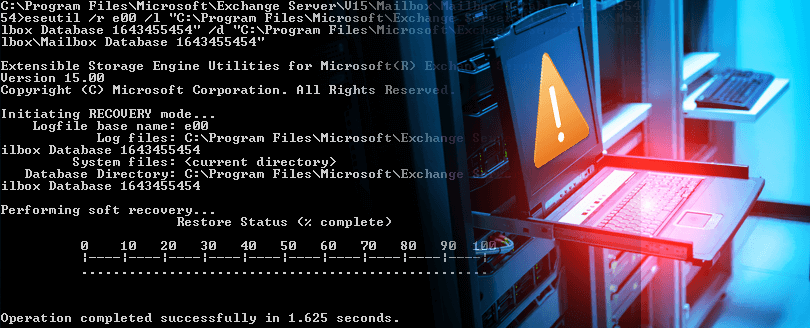Exchange database (EDB) files are the repositories of Exchange data. Exchange Server stores its data on EDB files and makes it available to users. But there are many errors and issues that Exchange administrators face while using Exchange Server. And sometimes, these databases can become unavailable to users when the database becomes corrupt or damaged.
In the present article, we will find a solution to the following Exchange Error –
Microsoft Exchange Server Database Storage Engine utilities have stopped working..
The error is quite self-explanatory as it dictates that the Database Storage Engine is not working and all the data you have stored in the database is unreachable. If you face this error, then it means that the Exchange Server will not be able to save your email messages, contacts, and notes.
Reasons for the Error
The major reason for the “Microsoft Exchange Server Database Storage Engine utilities have stopped working” error is the Exchange dirty shutdown state which usually occurs due to sudden closing of the Exchange application due to power failure or other reasons. In this situation, the Exchange database fails to maintain consistency and shows this error.
How to Fix the Error?
“Microsoft Exchange Server Database Storage Engine utilities have stopped working” is relatively a minor issue. To fix the issue, there are two options available which you can choose as per your convenience –
1. Restore the database using the Exchange Backup file.
2. Repair the corrupt Exchange Database with the help of the ESEUTIL tool.
Restoring the database with the help of the backup file seems a practical option. If there are some important messages in the mailbox of which you have not taken a backup recently, this method will be fruitless. Restoring a database also does not provide any guarantee that the error will not occur again. That’s why the majority of Exchange Administrators like to go for the ESEUTIL tool.
How to Repair a Corrupt Database Using the ESEUTIL Tool?
ESEUTIL is an in-built repairing tool present in the Exchange Server setup itself. You can directly access it and run various commands. This can be used for performing multiple actions for repair and restoring.
The default location of the ESEUTIL tool is –
C:\Program Files\Microsoft\Exchange Server\V15\Bin
Here, the available switches are –
ESEUTIL /D – it is used to defragment the database.
ESEUTIL /R – it restores the database.
ESEUTIL /G – it checks the integrity of the database.
ESEUTIL /K – it checks the checksums in the database.
ESEUTIL /P – it repairs the database.
ESEUTIL /M – it can check headers, log files, and checkpoints of the database.
ESEUTIL /Y – it can copy the database files.
ESEUTIL /C – it can hard repair the database.
NOTE – Before starting the recovery of databases, you should take a backup of the database because the process requires defragmentation of the database. The process of repairing the corrupt database with the ESEUTIL tool and its switches is following –
1. Defragment the database.
Defragmentation of the database is required to remove the white spaces from the Exchange database. It helps in increasing the readability of database; the ESEUTIL tool can scan the database and defragment it.
Before the defragmentation, check the free space of the database using the following command in EMS –
Get-MailboxDatabase -Status | databasesize,availablemailboxspace
After running this command, you will get the complete information of the available free space. To claim the free space, you can use the ESEUTIL tool. First, dismount the database.
Dismount-Database -Identity databasename
Now, run the ESEUTIL command
ESEUTIL /D databasename /T UNC-Path
It will save the temporary files created during the defragmentation process.
After that, mount the database back to the Exchange.
Mount-Database -Identity databasename
Now, rerun the first command to check about the recovered blank space.
Get-MailboxDatabase -Status | databasesize,availablemailboxspace
After recovering the blank space, you may go ahead for database recovery.
2. Repair the database.
If you have the log files, then the recovery procedure is quite easy, and you can use the soft recovery using the ESEUTIL tool.
ESEUTIL /r LogPrefix /l PathofLogFile /d PathofDatabaseFolder
The ESEUTIL tool will restore the database with the help of log files.
If you do not have the log files, then you need to perform the hard recovery using the following command
ESEUTIL /p PathofDatabase
After completing the hard recovery, the tool will provide a successful message.
The hard recovery of the exchange database using the ESEUTIL tool may be useful, but the Exchange experts do not advise it. Because the ESEUTIL tool may delete the data and there is no method to recover the deleted data. That’s why the ESEUTIL utility is not the perfect solution for restoring the Exchange Server Database storage engine.
Exchange Server Recovery Software
Exchange Server recovery software is a data recovery tool for repairing the corrupt Exchange database files which are dismounted from Exchange Server. It can help you to restore the Exchange data by removing the corruption of the database. After extracting the useful data, you can directly save them to Live Exchange, Outlook PST, or Office 365 and access the data instantly. This tool supports all Exchange Server versions from Exchange 2007 to Exchange 2019. So, it is an essential tool for all Exchange administrators.
